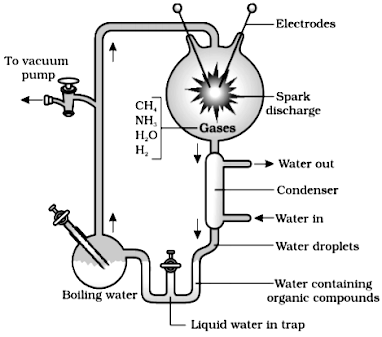Harold C. Urey; an astronomer in 1952 provided the first adequate recognition to oparin-Haldane’s view in university of Chicago. Urey asked his student Stanely L. Miller; a biochemist to replicate the primordial atmosphere as explained by Oparin – Haldane.
 |
| Miller |
 |
| Urey |
 |
MillerUrey experiment |
The energy was provided by heating the flask at temperature
about 8000C and by electric sparks from electrodes in gaseous
chamber.
Miller circulated four gases— methane, ammonia, hydrogen and
water vapour in an airtight apparatus and passed electrical discharges from
electrodes at 800°C. He passed the mixture through a condenser.
The experiment was run continuously in this way for one week and
then analyzed the chemical composition of the liquid inside the apparatus.
He found a large number of simple organic compounds including
some amino acids such as alanine, glycine and aspartic acid. Miller conducted the experiment to test the idea that
organic molecules could be synthesized in a reducing environment.
Other substances, such as urea, hydrogen cyanide, lactic acid
and acetic acid were also present.
They also performed another experiment by removing electrodes but the complex molecules were not formed.
They concluded that electric discharge produced during lightning
in primitive atmosphere of earth with H2 , N2, NH3, CH4, water vapours etc
might have resulted in the formation of aminoacids and other building blocks of
living organisms in primitive earth.
Later on, many investigators have synthesized a great variety
of organic compounds including purines, pyrimidines and simple sugars, etc. It
is considered that the essential ‘building blocks’ such as nucleotides, amino
acids, etc. of living organisms could thus have formed on the primitive earth.
Bahadur (1954) obtained all possible aminoacids by subjecting a
mixture of ammonia, ferric chloride and formaldehyde.
Melvin and Calvin produced aminoacids and sugars by treating a
mixture of H2, water vapours, NH3 and CH4.